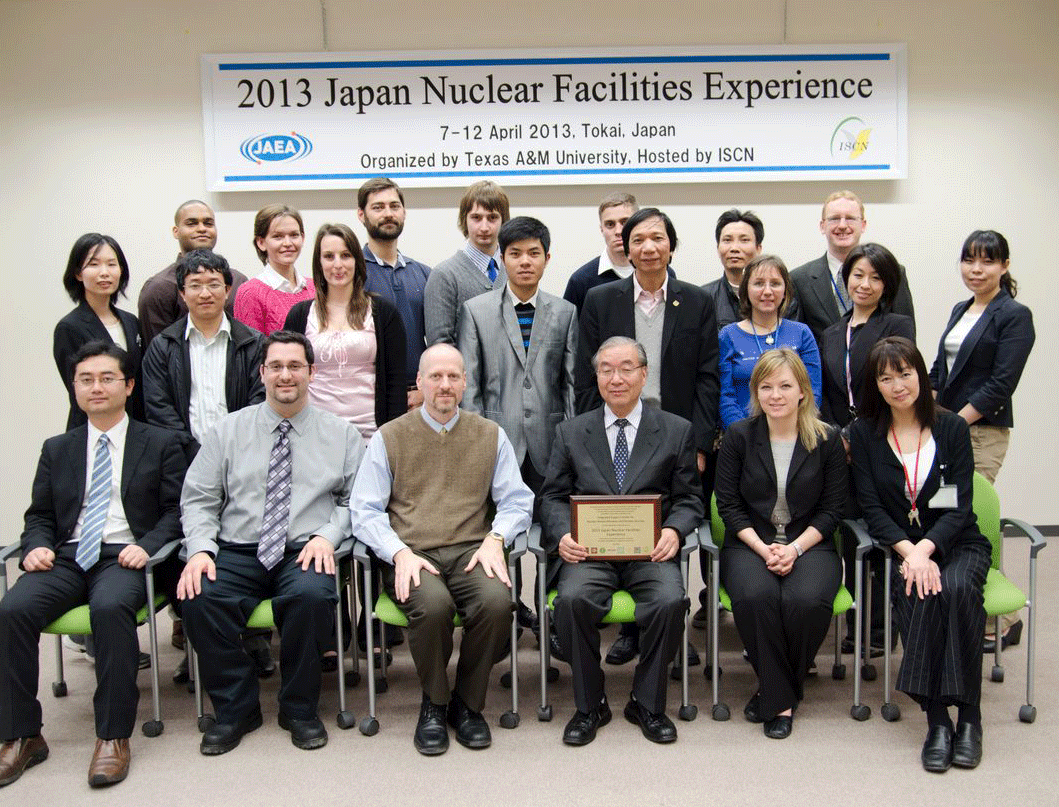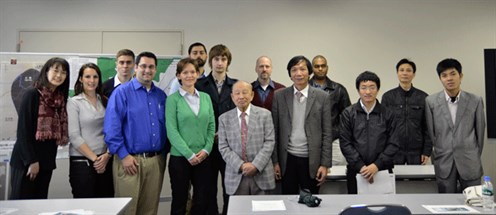
The Nuclear Security Science and Policy Institute (NSSPI) at Texas A&M University recently conducted the 2013 Nuclear Facilities Experience (NFE) in Japan. The event was co-coordinated with the Integrated Support Center for Nuclear Nonproliferation and Nuclear Security (ISCN) of the Japan Atomic Energy Authority.
Participants in the NFE included students and professors from Texas A&M, the Tomsk Polytechnic University of Russia, and the Hanoi University of Science of the Vietnamese National University. Dr. William Charlton, director of NSSPI and an associate professor in Texas A&M’s Department of Nuclear Engineering, and NSSPI associate research engineer Claudio Gariazzo led the group on tours of facilities and historically significant sites throughout Japan.
The NFE served as a unique opportunity for university students to visit nuclear fuel cycle facilities in Japan and discuss applied safeguards and security measures with actual practitioners and facility operators. The first day’s activities included visiting the historically significant Hiroshima Peace Park and the Peace Memorial Museum as well as hearing 84-year-old Keijiro Matsushima’s account of the Aug. 6th, 1945 bombing of Hiroshima. According to the attendees, it was a truly inspiring moment and properly conveyed the importance and gravity of the nuclear nonproliferation problem the world faces today.
– Claudio Gariazzo, NSSPI Associate Research Engineer and NFE coordinator
The technical visits began at the Monju Fast Breeder Reactor R&D Center and the Fugen Decommissioning Center on the Tsuruga peninsula where NFE participants met with facility operators and material control and accounting practitioners of both facilities and toured various areas open only for the NFE. The Monju visit was intended to show students the unique implementation of the safeguards system for sodium-cooled reactors and convey the safety challenges of a sodium-based coolant system. The visit to Fugen was focused on the plutonium nondestructive assay system being installed and understanding the requirements of applied safeguards and safety measures for decommissioning an advanced thermal reactor facility.
Participants also visited the Mihama Nuclear Power Plant (NPP) and met with the applied safeguards specialists. Tours included visits to the fresh and spent fuel ponds as well as the containment vessel.
The group visited the host organization, ISCN, and other facilities at the site, namely the Plutonium Fuel Production Facility (PFPF) and the Tokai Reprocessing Technology Development Center (TRTDC). While at the ISCN, participants witnessed current research and development activities in physical security and met with the director of the center, Masao Senzaki, who is a board member of INMM-Japan). Charlton presented Senzaki with a plaque thanking the ISCN for its substantial contributions to the NFE and nuclear safeguards/security education.

Group photo with Hiroshima survivor Keijiro Matsushima
International Atomic Energy Agency (IAEA) inspector Georges Duhamel presented work completed by the IAEA on implementing safeguards to the Fukushima Dai-ichi nuclear power plant after the accident in 2011 and how the agency plans to meet the needs of long-term accounting of melted spent reactor fuel. The PFPF and TRTDC visits aimed to educate the NFE participants on the safeguards implementation on a MOX (mixed-oxide) fuel production facility and a reprocessing facility.

Lunch with Tokyo Institute of Technology Professors and Students
Students and professors at the Tokyo Institute of Technology hosted the NFE participants for a cultural excursion and a lunch. During this activity, students representing the United States, Russia, Vietnam, Japan, China, and France interacted and held lively discussions from their own perspectives on nuclear energy, nonproliferation, global politics, sports, and cuisine.
On the final day of the event the NFE participants visited the Japan Nuclear Fuel Limited Rokkasho Uranium Enrichment Plant, the Vitrification Storage Facility and the Reprocessing Plant. Here students were able to step through the entire reprocessing process as well as discuss the applied nuclear security and safeguards measures with the facility practitioners.

NFE Participants standing over the Monju (sodium-cooled) FBR